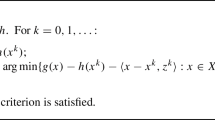Abstract
In this paper we consider a portfolio selection problem under the global minimum variance model where the optimal portfolio weights only depend on the covariance matrix of asset returns. First, to reflect the rapid changes of financial markets, we incorporate a time-varying factor in the covariance matrix. Second, to improve the estimation of the covariance matrix we use the shrinkage method. Based on these two key aspects, we propose a framework for shrinking the time-varying inverse conditional covariance matrix in order to enhance the performance of the portfolio selection. Furthermore, given the shortcoming that the inverse covariance matrix is inaccurate in a number of cases, we develop a new method that transforms the inverse of the covariance matrix into a product to improve the performance of the inverse covariance matrix, and prove its theoretical availability. The proposed portfolio selection strategy is applied to analyze real-world data and the numerical studies show it performs well.
Similar content being viewed by others
References
Ausin MC, Lopes HF (2010) Time-varying joint distribution through copulas. Comput Stat Data Anal 54(11):2383–2399
Bai JS, Shi SZ (2011) Estimating high dimensional covariance matrices and its applications. Ann Econ Finan 12(2):199–215
Bastürk N, Almeida RJ (2016) Time varying correlation estimation using probabilistic fuzzy systems. Commun Comput Inform Sci 611:752–763
Bodnar T, Mazurb S, Podgórskib K (2016) Singular inverse Wishart distribution and its application to portfolio theory. J Multivar Anal 143:314–326
Bollerslev T (1990) Modelling the coherence in short-run nominal exchange rates: a multivariate generalized ARCH model. Rev Econ Stat 72(3):498–505
Chopra V, Ziemba W (1993) The effect of errors in means, variances, and covariances on optimal portfolio choice. J Portf Manag 19(2):6–12
DeMiguel V, Garlappi L, Uppal R (2009a) Optimal versus naive diversification: how inefficient is the \(1/N\) portfolio strategy? Rev Finan Stud 22(5):1915–1953
DeMiguel V, Garlappi L, Nogales FJ, Uppal R (2009b) A generalized approach to portfolio optimization: improving performance by constraining portfolio norms. Manag Sci 55(5):798–812
Ding T, Kou Y, Ma ZJ, Zhang YY, Yan H (2017) A robust mean variance optimization model for economic dispatch with wind power integration and evenly distributed Pareto front generation. Int Trans Electr Energy Syst 27(7):e2324
Engle RF (2002) Dynamic conditonal correlation: a simple class of multivariate generalized autoregressive conditional heteroskedasticity models. J Bussiness Econ Stat 20(3):339–350
Engle RF, Granger CWJ, Kraft D (1984) Combining competing forecasts of inflation using a bivariate ARCH model. J Econ Dyn Control 8(2):151–165
Frahm G (2010) Linear statistical inference for global and local minimum variance portfolios. Stat Pap 51(4):789–812
Gohout W, Specht K (2007) Mean-variance portfolios using Bayesian vector-autoregressive forcasts. Stat Pap 48(3):403–418
Ikeda Y, Kubokawa T (2016) Linear shrinkage estimation of large covariance matrices using factor models. J Multivar Anal 152:61–81
James W, Stein C (1961) Estimation with quadratic loss. In: Proceedings of the 4th Berkeley symposium on mathematical statistics and probability. University of California Press, Los Angeles, pp 361–379
Jobson DJ, Korkie BM (1980) Estimation for Markowitz efficient portfolios. J Am Stat Assoc 75(371):544–554
Kourtis A, Dotsis G, Markellos RH (2012) Parameter uncertainty in portfolio selection: shrinkage the inverse covariance matrix. J Bank Financ 36(9):2522–2531
Kroner KF, Claessens S (1991) Optimal dynamic hedging portfolios and the currency composition of external debt. J Int Money Financ 10(1):131–148
Lan W, Wang HS, Tsai C (2012) A Bayesian information criterion for portfolio selection. Comput Stat Data Anal 56(1):88–99
Ledoit O, Wolf M (2003) Improved estimation of the covariance matrix of stock returns with an application to portfolio selection. J Empir Financ 10(5):603–621
Ledoit O, Wolf M (2004) A well-conditioned estimator for large-dimensional covariance matrices. J Multivar Anal 88:365–411
Markowitz HM (1952) Portfolio selection. J Financ 7(1):77–91
Merton RC (1980) On estimating the expected return on the market: an exploratory investigation. J Financ Econ 8(4):323–361
Santos AAP, Moura GV (2014) Dynamic factor multivariate GARCH model. Comput Stat Data Anal 76:606–617
Sharpe WF (1963) A simplified model for portfolio analysis. Manag Sci 9(2):277–293
Stein C (1975) Estimation of a covariance matrix. Rietz Lecture, 39th Annual Meeting IMS. Atlanta
Stevens GVG (1998) On the inverse of the covariance matrix in portfolio analysis. J Financ 53(5):1821–1827
Tse YK, Tsui AKC (2002) A multivariate generalized autoregressive conditional heteroscedasticity model with time-varying correlations. J Business Econ Stat 20(3):351–362
Wied D, Ziggel D, Berens T (2013) On the application of new tests for structural changes on global minimum-variance portfolios. Stat Pap 54(4):955–975
Acknowledgements
We would like to thank the Editor and Referees very much for their constructive comments, which significantly helped us to improve the manuscript. The first two authors’ research was supported by the Fundamental Research Funds for Central Universities, China (Nos. JBK1607121, JBK120509, JBK140507, JBK141111). This study was also supported by the National Natural Science Foundation of China (Nos. 11471264, 11401148, 51437003).
Author information
Authors and Affiliations
Corresponding author
Appendix
Appendix
1.1 A1. Complete expression of (8)
Assume that G, M and \(G+M\) are invertible matrices, then we have
Using the above formula, we have
where
1.2 A2. Proof of Proposition 1
Taking the derivative of \({\widehat{\beta }}_{i}\) with respect to \(\beta _{1}\), we obtain
Similarly, we have
We can reformulate the above formulas in terms of D and b, \(DK=b\), where \(K=(\beta _{1},\beta _{2},\beta _{3})^\top \). So, \(\varXi =D^{-1}b\). The proof is complete. \(\square \)
1.3 A3. Proof of Proposition 2
Similar to the proof of Proposition 1, we can get \(DK=b\), where \(K=(\beta _{1},\beta _{2},\beta _{3},\beta _{4})^\top \). Then, we have \(\varXi =D^{-1}b\). The proof is complete. \(\square \)
1.4 A4. Proof of Proposition 3
Let \(\varPhi =\varOmega -I\), then \(\varPhi \) and \(I-\varPhi +\varPhi ^{2}\) are symmetric.
So, \(I-\varPhi +\varPhi ^{2}\) is positive definite. The proof is complete. \(\square \)
Rights and permissions
About this article
Cite this article
Sun, R., Ma, T. & Liu, S. Portfolio selection: shrinking the time-varying inverse conditional covariance matrix. Stat Papers 61, 2583–2604 (2020). https://doi.org/10.1007/s00362-018-1059-0
Received:
Revised:
Published:
Issue Date:
DOI: https://doi.org/10.1007/s00362-018-1059-0




